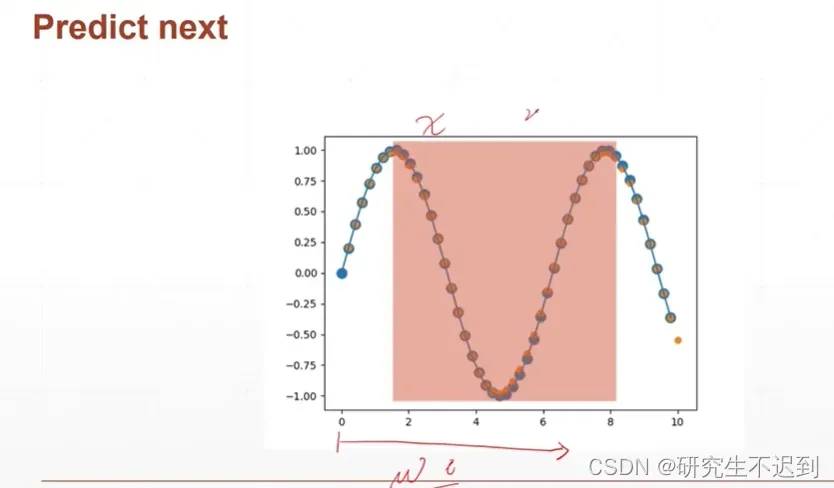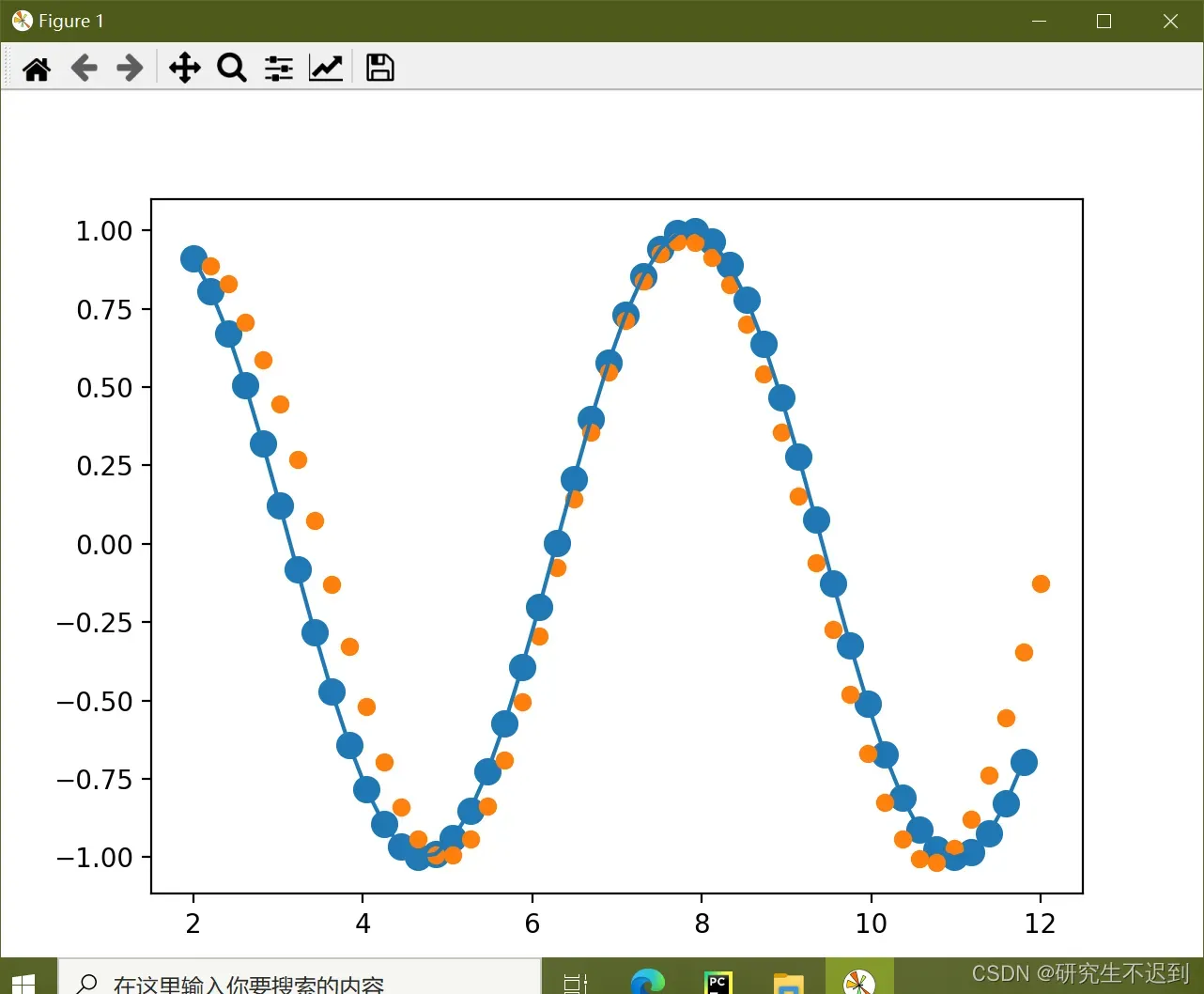1 问题描述
给定50个正弦函数的数据对(x, y), 划分0~48(前49个)是训练数据集, (1~50)是预测数据集。
2 数据处理部分
num_time_steps = 50
start = np.random.randint(3, size=1)[0] # 返回[0,3)范围内的整数
time_steps = np.linspace(start, start + 10, num_time_steps)
data = np.sin(time_steps)
data = data.reshape(num_time_steps, 1)
x = torch.tensor(data[:-1]).float().view(1, num_time_steps - 1, 1)
y = torch.tensor(data[1:]).float().view(1, num_time_steps - 1, 1)
2.1 np.random.randint()
- 函数原型
randint(low, high=None, size=None, dtype=None)
- 参数介绍
(1)low : int
表示生成的数值大于等于low。
但是如果hign = None时,生成的数值要在[0, low)区间内 【代码中用的就是这一种,表示生成的是[0,3) 之间的一个整数】
(2)high : int (可选,默认None)
如果使用这个值,则生成的数值在[low, high)区间
(3)size : int or tuple of ints(可选)
输出随机数组的尺寸,比如size = (m, n, k),则输出数组的shape = (m, n, k),数组中的每个元素均满足要求。
size默认为None,仅仅返回满足要求的单一随机数。
(4)dtype : dtype(可选):
想要输出的格式。如int64、int等等
2.2 np.linspace()
- 函数原型
linspace(start, stop, num=50, endpoint=True, retstep=False, dtype=None,
axis=0):
- 参数介绍:
(1)start : 返回样本数据开始点
(2)stop : 返回样本数据结束点
(3)num : 生成的样本数据量,默认为50
(4)endpoint:True则包含stop;False则不包含stop
(5)retstep:If True, return (samples, step), where step is the spacing between samples.(即如果为True则结果会给出数据间隔)
(6)dtype:输出数组类型
(7)axis:0(默认)或-1
在代码中, time_steps = np.linspace(start, start + 10, num_time_steps) 表示在[start , start+10)中等距生成50个点。
- 例如:
time = np.linspace(3, 13, 50)
time
array([ 3. , 3.20408163, 3.40816327, 3.6122449 , 3.81632653,
4.02040816, 4.2244898 , 4.42857143, 4.63265306, 4.83673469,
5.04081633, 5.24489796, 5.44897959, 5.65306122, 5.85714286,
6.06122449, 6.26530612, 6.46938776, 6.67346939, 6.87755102,
7.08163265, 7.28571429, 7.48979592, 7.69387755, 7.89795918,
8.10204082, 8.30612245, 8.51020408, 8.71428571, 8.91836735,
9.12244898, 9.32653061, 9.53061224, 9.73469388, 9.93877551,
10.14285714, 10.34693878, 10.55102041, 10.75510204, 10.95918367,
11.16326531, 11.36734694, 11.57142857, 11.7755102 , 11.97959184,
12.18367347, 12.3877551 , 12.59183673, 12.79591837, 13. ])
2.3 最终的数据情况
- data.shape : 50 × 1
- x的数据内容是data的 0~48(共计49个数), y的数据内容化是data 的1~ 49(共计49个数), (x, y)是一组数据对,是相邻的两个数据。
- 最后reshape了 x和y ,shape 是 [1, 49, 1], 再把np类型的数据转换为torch.tensor 这样才能喂给模型。
3 模型介绍
- 在看这一部分内容,一定要有RNN的基础知识,比如说输出数据的 shape, 中间memory 的shape 和最后输出的数据的shape 之间的关系,如果不清楚的话,可以看我同系列的 时间序列学习(1~3)
3.1 模型代码
input_size = 1
hidden_size = 16
output_size = 1
class Net(nn.Module):
def __init__(self, ):
super(Net, self).__init__()
self.rnn = nn.RNN(input_size=input_size, hidden_size=hidden_size, num_layers=1, batch_first=True)
self.linear = nn.Linear(in_features=hidden_size, out_features=output_size)
def forward(self, x, hidden_prev):
out, hidden_prev = self.rnn(x, hidden_prev)
# [b, seq, h]
out = out.view(-1, hidden_size)
out = self.linear(out)
out = out.unsqueeze(dim=0)
return out, hidden_prev
3.2 介绍 init 函数
init 函数中,定义了两个层,一个是 rnn 一个是linear
- 对于rnn层,看参数中的 batch_first=True , 说明这里喂给rnn 的数据应该是 :[batch , seq, feature] (就是把batch提前,因为batch_first = True 嘛)
- 然后就是 input_size=input_size=1 , 表示输入的数据的特征维度,因为这里就是数字数据,所以feature=1(不需要像词向量处理一样,把词转换成100d 的向量了)
- 对于hidden_size ,就是自己可以指定 数据在处理中的特征维度,比如说16, 20等等都是可以的,这里选择16
- num_layers=1 表示rnn 只有一层
- 对于linear层,in_features=hidden_size 表示输入数据的特征维度,out_features=output_size 表示输出数据的特征维度
3.3 介绍forward函数
- 该功能集成了模型的执行。
- 首先调用 self.rnn , 在调用时,需要传入两个参数,一个是训练数据x(x.shape = batch * seq * hidden_features);另一个是
,是一个在循环神经网络中的记忆单元,是会一直向后传播的。【可以不传入
直接让 rnn 自己生成也可以】
out, hidden_prev = self.rnn(x, hidden_prev)
- 对于 self.rnn 的输出,out 和hidden_prev 的shape,是可以根据前面的已有信息计算出来的。如果觉得推理麻烦,也可以使用 torchsummary 直接查看。
out.shape : [1, 49, 16]
hidden.prev.shape : [1, 1, 16]
# 首先安装 torchsummary
pip intall torchsummary
# 然后在需要引用的地方,用下面语句调用
summary(model, input_size, batch_size=-1, device="cuda")
#这里是函数原型
4 模型训练部分
model = Net()
criterion = nn.MSELoss()
optimizer = optim.Adam(model.parameters(), lr)
hidden_prev = torch.zeros(1, 1, hidden_size) # h0
for iter in range(1000):
start = np.random.randint(3, size=1)[0]
time_steps = np.linspace(start, start + 10, num_time_steps)
data = np.sin(time_steps)
data = data.reshape(num_time_steps, 1)
x = torch.tensor(data[:-1]).float().view(1, num_time_steps - 1, 1)
y = torch.tensor(data[1:]).float().view(1, num_time_steps - 1, 1)
output, hidden_prev = model(x, hidden_prev)
hidden_prev = hidden_prev.detach()
loss = criterion(output, y)
model.zero_grad()
loss.backward()
optimizer.step()
if iter % 100 == 0:
print("Iteration: {} loss {}".format(iter, loss.item()))
4.1 同数据处理部分
- 我不会详细介绍这一点。
start = np.random.randint(3, size=1)[0]
time_steps = np.linspace(start, start + 10, num_time_steps)
data = np.sin(time_steps)
data = data.reshape(num_time_steps, 1)
x = torch.tensor(data[:-1]).float().view(1, num_time_steps - 1, 1)
y = torch.tensor(data[1:]).float().view(1, num_time_steps - 1, 1)
4.2 喂数据给模型、计算loss、梯度更新,反向传播
- 传递给模型输入
和初始
- detach() 的作用是深拷贝
tensor.detach()是为了解决tensor.data()的安全性提出的。tensor.detach()相对较为安全。因为当通过.detach()得到的tensor间接修改原来的tensor后继续在计算图中使用时会报错,但是通过.data()得到的tensor间接修改原tensor后继续在计算图中使用就会被忽略被修改的过程
- criterion是前面定义的函数,然后就是反向传播的固定写法。
output, hidden_prev = model(x, hidden_prev)
hidden_prev = hidden_prev.detach()
loss = criterion(output, y)
model.zero_grad()
loss.backward()
optimizer.step()
if iter % 100 == 0:
print("Iteration: {} loss {}".format(iter, loss.item()))
5 模型预测部分
5.1 同数据处理部分
- 这里的一个问题是训练集和预测集交叉,这是不好的。
start = np.random.randint(3, size=1)[0]
time_steps = np.linspace(start, start + 10, num_time_steps)
data = np.sin(time_steps)
data = data.reshape(num_time_steps, 1)
x = torch.tensor(data[:-1]).float().view(1, num_time_steps - 1, 1)
y = torch.tensor(data[1:]).float().view(1, num_time_steps - 1, 1)
predictions = []
input = x[:, 0, :]
for _ in range(x.shape[1]):
input = input.view(1, 1, 1)
(pred, hidden_prev) = model(input, hidden_prev)
input = pred
predictions.append(pred.detach().numpy().ravel()[0])
6 画图
x = x.data.numpy().ravel()
y = y.data.numpy()
plt.scatter(time_steps[:-1], x.ravel(), s=90)
plt.plot(time_steps[:-1], x.ravel())
plt.scatter(time_steps[1:], predictions)
plt.show()

7 完整代码,可以直接运行
- 如果你觉得对你有帮助,请点赞和关注我!你的支持是我分享的动力~
import numpy as np
import torch
from torch import nn, optim
import matplotlib.pyplot as plt
from torchsummary import summary
import os
os.environ["KMP_DUPLICATE_LIB_OK"] = "TRUE"
num_time_steps = 50
input_size = 1
hidden_size = 16
output_size = 1
lr = 0.01
hidden_prev = torch.zeros(1, 1, hidden_size)
class Net(nn.Module):
def __init__(self, ):
super(Net, self).__init__()
self.rnn = nn.RNN(input_size=input_size, hidden_size=hidden_size, num_layers=1, batch_first=True)
self.linear = nn.Linear(hidden_size, output_size)
def forward(self, x, hidden_prev):
out, hidden_prev = self.rnn(x, hidden_prev)
# [b, seq, h]
print(out.shape, hidden_prev.shape)
out = out.view(-1, hidden_size) # [1, seq, hidden] -> [seq, hidden]
out = self.linear(out) # [seq, hidden] -> [seq, 1]
out = out.unsqueeze(dim=0) # -> [1, seq, 1] 这里要和y做均方差
return out, hidden_prev
model = Net()
criterion = nn.MSELoss()
optimizer = optim.Adam(model.parameters(), lr)
hidden_prev = torch.zeros(1, 1, hidden_size) # h0
for iter in range(1000):
start = np.random.randint(3, size=1)[0]
time_steps = np.linspace(start, start + 10, num_time_steps)
data = np.sin(time_steps)
data = data.reshape(num_time_steps, 1)
x = torch.tensor(data[:-1]).float().view(1, num_time_steps - 1, 1)
y = torch.tensor(data[1:]).float().view(1, num_time_steps - 1, 1)
output, hidden_prev = model(x, hidden_prev)
hidden_prev = hidden_prev.detach()
loss = criterion(output, y)
model.zero_grad()
loss.backward()
optimizer.step()
if iter % 100 == 0:
print("Iteration: {} loss {}".format(iter, loss.item()))
start = np.random.randint(3, size=1)[0]
time_steps = np.linspace(start, start + 10, num_time_steps)
data = np.sin(time_steps)
data = data.reshape(num_time_steps, 1)
x = torch.tensor(data[:-1]).float().view(1, num_time_steps - 1, 1)
y = torch.tensor(data[1:]).float().view(1, num_time_steps - 1, 1)
predictions = []
input = x[:, 0, :]
for _ in range(x.shape[1]):
input = input.view(1, 1, 1)
(pred, hidden_prev) = model(input, hidden_prev)
input = pred
predictions.append(pred.detach().numpy().ravel()[0])
x = x.data.numpy().ravel()
y = y.data.numpy()
plt.scatter(time_steps[:-1], x.ravel(), s=90)
plt.plot(time_steps[:-1], x.ravel())
plt.scatter(time_steps[1:], predictions)
plt.show()
文章出处登录后可见!
